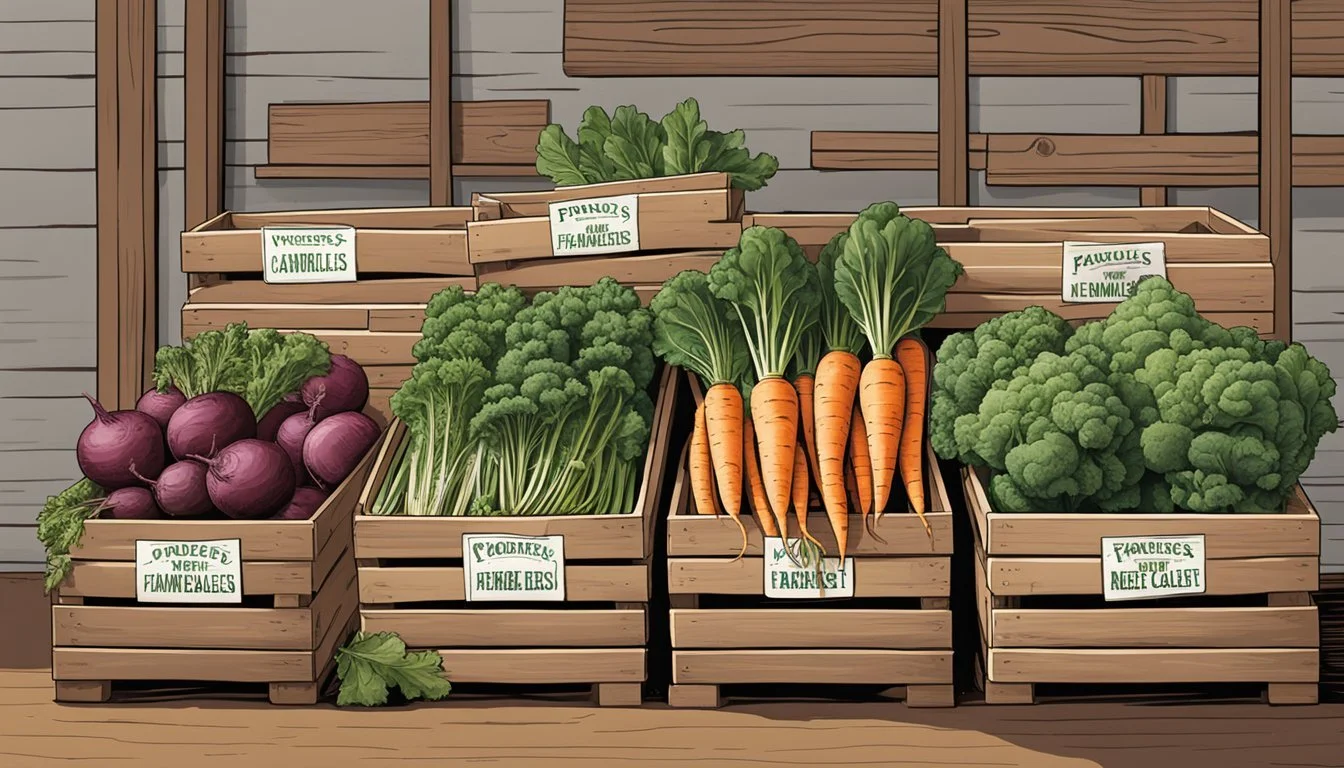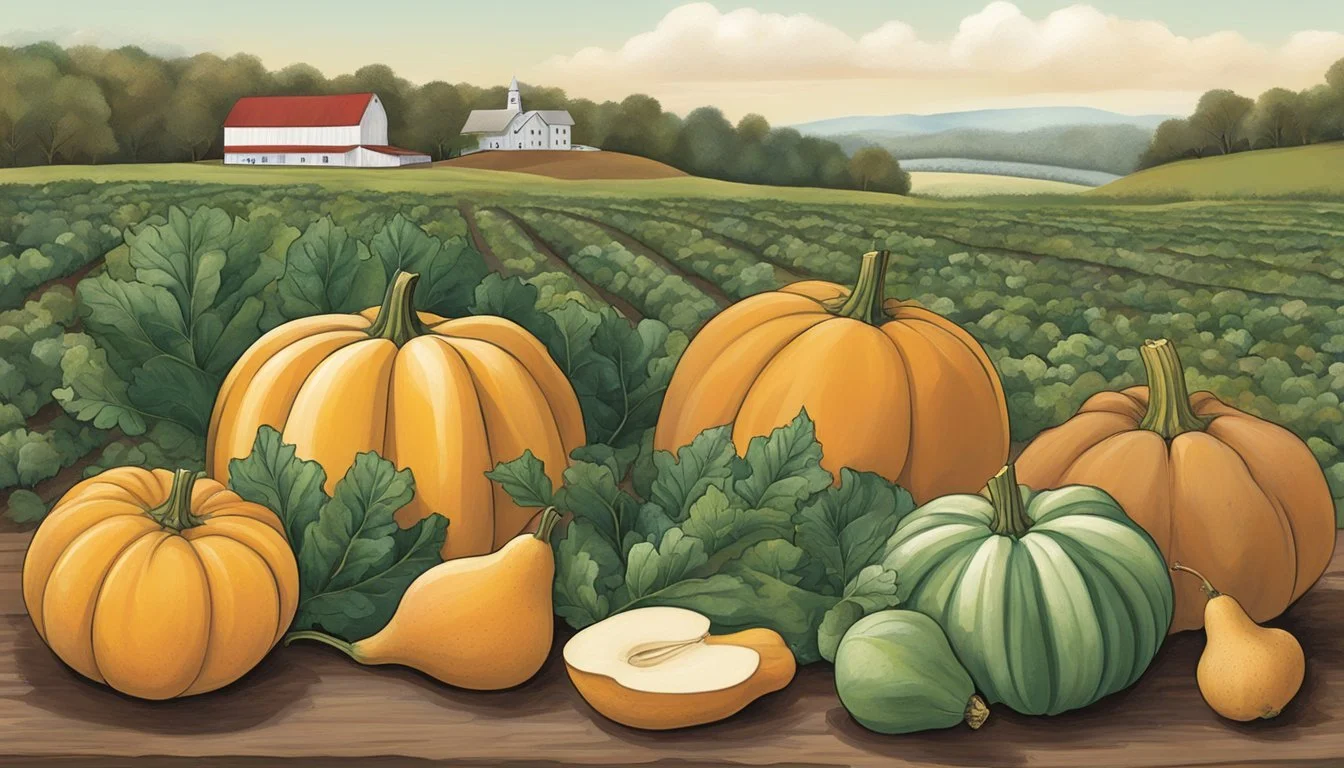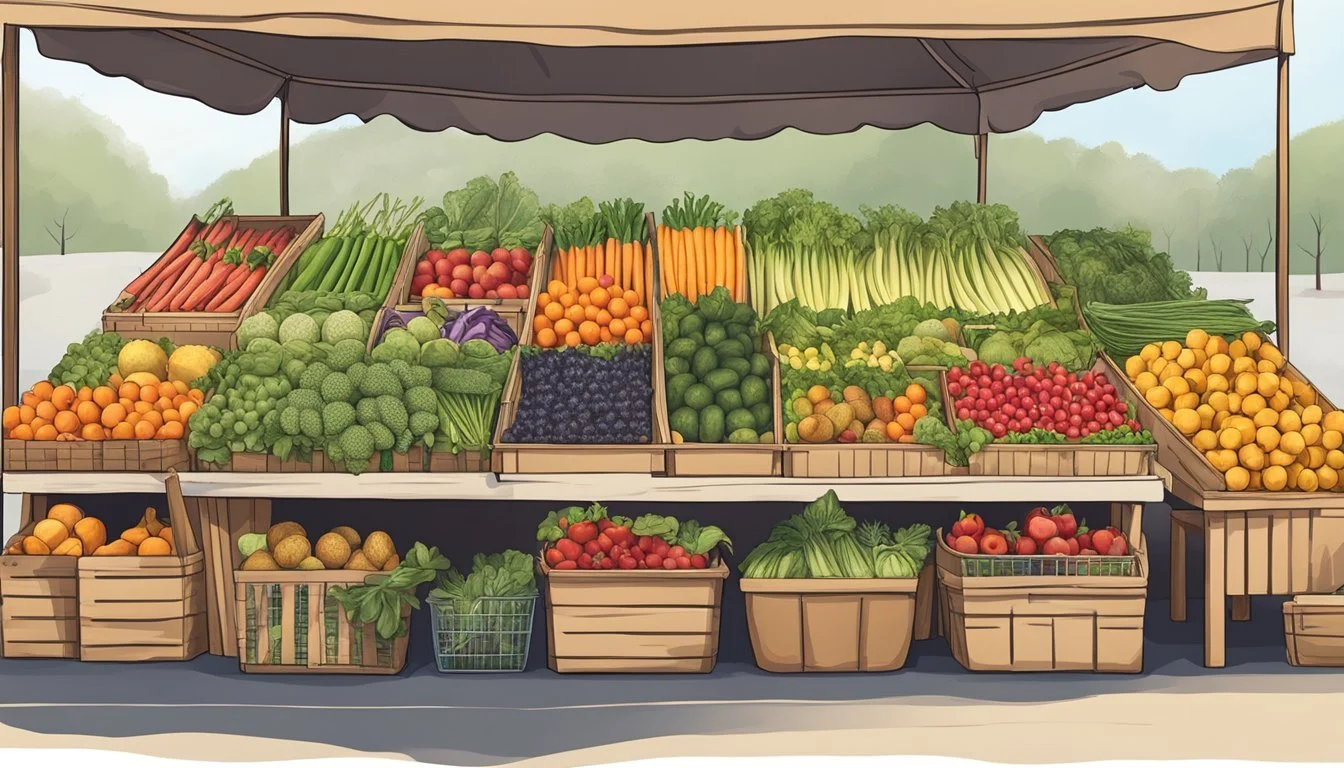Kentucky Seasonal Fruit & Vegetables in February
A Guide to Fresh Produce
This Article is Part of our Kentucky Seasonal Fruit & Veg Calendar
In the cool, often brisk month of February, Kentucky's seasonal produce selection pivots to hearty vegetables and the tail end of winter's citrus offerings. While the state’s fields may seem dormant, there are valuable crops that thrive in the chill of winter or are stored commodities from the previous fall harvest. Consumers and chefs alike look to these seasonal items to ensure freshness and support local agriculture.
Kentucky's February produce includes an array of root vegetables, such as carrots and potatoes, which remain hardy throughout the cold months. This period also marks the time for leafy greens like kale, which can withstand frosty conditions. Citrus fruits, while not typical of Kentucky's climate, are at their peak in many parts of the country, making them a fresh and available option in markets during this time.
Local farms may offer these crops alongside greenhouse-grown produce such as lettuces and herbs, providing a burst of freshness reminiscent of spring during the final stretch of winter. These items, together with stored apples (how long do apples last?) and pears from the previous year's harvest, round out the selection of fresh produce that can be found in Kentucky in February.
Overview of Kentucky's Seasonal Produce
During February, Kentucky's seasonal produce offers a limited but diverse range of fruits and vegetables to residents and visitors. The winter month poses challenges to cultivation, yet certain hearty crops thrive in these cooler temperatures.
Vegetables: February in Kentucky is a time for robust winter vegetables that can withstand the colder weather. Common selections from the local harvest include:
Broccoli (how long does broccoli last?)
Brussels sprouts (how long do brussels sprouts last?)
Cabbage
Cauliflower (how long does cauliflower last?)
Farmers take pride in the quality of these vegetables, as they represent the resilience and adaptability of Kentucky's agriculture.
Fruits: Fruit options are scarce in February due to the winter climate. However, some fruits are stored from autumn harvests and are still available, although not field-fresh. The selection typically consists of:
Apples (stored from fall)
Pears (stored from fall)
The availability of these fruits depends on the successes of the prior harvesting season and storage techniques.
The region acknowledges that choices are limited during the winter months, but Kentucky's farmers work diligently to maintain a supply of nutritious, seasonal produce. Consumers can confidently rely on the freshness and quality of the vegetables available, and take solace in the stored fruits that reflect the remnants of autumn's bounty.
Winter Vegetables in Kentucky
During the chilly month of February, a variety of hardy winter vegetables continue to thrive in Kentucky's cold climate. Residents can enjoy fresh produce by relying on the resilient characteristics of certain root and leafy vegetables as well as those from the cruciferous family.
Root Vegetables
Root vegetables fare well during Kentucky's winter, with their ability to grow underground and withstand frost. Carrots, turnips, beets (how long do beets last?), and radishes are excellent choices for seasonal harvest. Parship, with its sweet flavor when cooked, remains a popular winter staple. Sweet potatoes are another hardy choice, storing warmth deep within the earth to provide a nutritious addition to winter meals. Onions and garlic also continue to be available, providing robust flavors essential for hearty winter dishes.
Carrots: Known for their versatility and sweet flavor.
Turnips: A root vegetable with a peppery taste, ideal for stews.
Beets: Deep red and packed with nutrients, suitable for a variety of dishes.
Radishes: Offer a crisp, spicy kick to salads and side dishes.
Parsnip: Provides a sweet, nutty flavor to soups and roasts.
Sweet Potato: A rich source of vitamins, excellent for baking and mashes.
Onions & Garlic: Essential for flavoring a multitude of winter recipes.
Leafy Greens
Leafy greens can persist through the cold months, with some varieties like kale, spinach, and collard greens (how long do collard greens last?) capable of withstanding low temperatures. Spinach remains a favorite for its tender leaves and mild taste, while kale and collard greens provide a hearty texture and a slightly bitter flavor profile, suitable for warm dishes.
Kale: Rich in nutrients and perfect for sautés and chips.
Spinach: Soft and versatile, a great addition to both cooked and raw meals.
Collard Greens: Ideal for slow-cooking, adding a nutritious touch to comfort foods.
Cruciferous Vegetables
Cruciferous vegetables, known for their health benefits, are readily available in February. Cabbage, broccoli, Brussels sprouts, and cauliflower are thriving during this time, offering vibrant greens to the winter palette.
Cabbage: Comes in various varieties, each with a unique taste for slaws and soups.
Broccoli: A staple vegetable that can be steamed, roasted, or added to casseroles.
Brussels Sprouts: When roasted, they develop a nutty, caramelized flavor.
Cauliflower: Extremely versatile, can be eaten raw, roasted, or used as a low-carb substitute.
These vegetables are not only adaptable to the winter season but also provide the nutrients necessary to sustain health during the colder months in Kentucky.
Winter Fruits Available in Kentucky
In February, Kentucky's winter fruits are limited due to the cold climate. However, certain fruits like citrus and stored apples still offer fresh flavors during this time.
Citrus Fruits
Kentucky is not a traditional citrus-growing state due to its winter climate; however, citrus fruits like lemons, oranges, grapefruit, and blood oranges are often available through markets, having been transported from warmer regions. Citrus fruits do not grow natively in Kentucky during the winter but remain a popular seasonal import.
Lemons: Known for their bright, acidic flavor.
Oranges: A sweet and juicy staple found in many winter dishes and snacks.
Grapefruit: Offers a tangy and somewhat bitter taste, providing a vibrant start to the day.
Blood Oranges: They stand out with their distinctive crimson-colored flesh and a slightly sweet berry-like flavor compared to regular oranges.
Cooking and Preparation Tips
In February, Kentucky's seasonal produce offers a wealth of flavors and textures ideal for varied cooking techniques. Whether one seeks to enjoy the crisp freshness of salads or the comforting warmth of hearty dishes, the local bounty provides ample opportunity for culinary creativity.
Salads and Raw Uses
One can highlight the best of winter's crisp produce by making salads. Kale, for instance, serves well in salads, especially when massaged with a light vinaigrette to soften its tough fibers. This leafy green can also be incorporated into smoothies for a nutrient-packed beverage. For a vibrant coleslaw, one might shred cabbage and carrots, then dress them with a smooth, tangy dressing.
Kale Recipes:
Massaged kale salad with lemon dressing
Kale and apple smoothie
Coleslaw:
Combine shredded cabbage and carrots
Mix with a mayonnaise or vinegar-based dressing
Hearty Winter Dishes
The cold month of February calls for warm, comforting dishes and Kentucky's seasonal vegetables are perfect for soups and stews. Root vegetables can be roasted to bring out their natural sweetness or mashed for a creamy side dish. One can also cook heartening vegetable stews that feature a medley of seasonal produce simmered to perfection.
Soups:
Roasted winter squash soup
Hearty vegetable stew with chunks of potatoes and carrots
Roasted Vegetables:
Beets, carrots, and turnips drizzled with olive oil and roasted until tender
Desserts and Sweet Treats
When it comes to desserts, seasonal Kentucky fruits lend themselves to baked goods and pies. Apples and pears can be cooked down into delectable fillings or sliced thin for tarts. These fruits also work wonderfully in crisps and crumbles, paired with warming spices like cinnamon and nutmeg (how long does nutmeg last?).
Desserts:
Baked apple slices with a sprinkle of brown sugar and cinnamon
Pear crumble with a buttery oat topping
Pies:
Classic apple pie with a flaky crust
Pear and cranberry pie for a tart, sweet dessert
Health Benefits of Seasonal Eating
Eating fruits and vegetables at their seasonal peak offers a host of health benefits. They are typically richer in nutrients when they are harvested at the optimal time of year, which can contribute positively to a healthy diet.
For instance, Kentucky's seasonal produce in February may include nutrient-packed vegetables like kale and fruits such as apples. These raw and fresh options are not only more flavorful but they also retain more vitamins and minerals. Consumers tend to get a wider variety of nutrients by rotating their produce selection according to the season, which can enhance overall health.
Integrating seasonal fruits and vegetables into one's diet supports a balanced intake of dietary fiber, essential vitamins, and antioxidants. These components are vital in maintaining a healthy digestive system, boosting immune health, and reducing the risk of chronic diseases.
One notes the economic and ecological advantages as well. Seasonal produce often requires less transportation and storage, leading to a reduced ecological footprint and offering a budget-friendly choice for consumers.
Seasonal Produce Nutritional Benefits Kale High in vitamins A, C, and K Apples Good source of fiber and vitamin C
In summary, incorporating seasonal produce into one's diet not only supports personal health but also benefits the local community and environment.
Kentucky's Seasonal Food Calendar
In February, Kentucky experiences cold weather, which shifts the focus to stored fruits and hearty vegetables from previous harvests. The local produce available during this period is limited due to the climate.
Vegetables:
The hearty vegetables that are available through storage from the previous harvest include:
Potatoes
Winter squash
Though not at the peak of their season, some farms may still offer greens stored through preservation methods used during their growing seasons.
As spring approaches in March, Kentuckians anticipate the beginning of asparagus season, which typically starts by April 20th and extends to early June. This marks the start of the fresh produce season after the winter months.
Fruit:
In terms of fruit, February does not offer an abundance due to the cold season. However, stores of apples from the previous harvest in late summer through fall—June 30th to November—remain a staple.
As the calendar progresses, May ushers in a more diverse variety of fresh produce. June and July are the prime months for fruits such as berries, with blackberries being plentiful from June 20th to July 20th.
The produce season peaks further in September when a wide range of fruits and vegetables is harvested.
Winter:
During January, the selection again becomes more dependent on stored and preserved goods, akin to February's offerings, as Kentucky food producers prepare for the renewal of the seasonal cycle in the upcoming spring months.
This calendar reflects a general guide, as weather conditions can impact the exact availability of crops. Consumers are encouraged to contact local farms for the most current information.
Finding Local Produce in Kentucky
Kentucky boasts a variety of local produce options available throughout the year, and consumers can find fresh seasonal produce in several ways, by connecting with local farmers directly or exploring city grocery stores and specialized food departments.
Farmers Markets and Local Farms
Farmers Markets are vibrant gathering places where one can directly purchase the freshest seasonal produce. In February, consumers might find winter produce like kale and root vegetables. Local farms might also offer purchase opportunities through Facebook or Pinterest, where they showcase available produce and seasonal specialties.
Locations: State-wide, check city event listings.
Availability: May vary; winter hours in effect.
Grocery Stores and Food Departments
Grocery Stores in Kentucky often feature a Dept for local and seasonal produce, supporting the state's agriculture. Food Departments may highlight what's in season, providing customers with information on peak freshness.
Local Produce Section: Look for signs indicating Kentucky-grown produce.
Seasonal Availability: Check store postings or online platforms for updates.
Sustainability and Support for Local Economy
In Kentucky, sustainability and economic vitality are closely intertwined, especially in the context of local agriculture. Local farmers are pivotal to this dynamic, often utilizing sustainable practices that benefit the environment and community. Kentucky farmers are known for their commitment to eco-friendly and organic farming methods, which in turn supports the local economy by creating jobs and contributing to the state's financial well-being.
Sustainable Harvest Farm and similar entities offer prime examples of this relationship. They not only provide a diversity of in-season fruits and vegetables but also enhance the soil's health and reduce the carbon footprint by minimizing transportation distances for produce.
Supporting local agriculture in Kentucky also means consumers receive fresher and potentially more nutritious produce. Seasonal offerings in February may be limited due to the colder climate, but cold-hardy crops are still accessible. Here's a quick glance at some of the available produce during this month:
Greens: kale, spinach
Root Vegetables: sweet potatoes, carrots
When consumers choose to buy locally, they uphold a sustainable economy, fostering a tighter-knit community. Local farms are essential to the commonwealth, as they:
Preserve open space
Use fewer agricultural chemicals
Promote biodiversity
Offer education on sustainable practices to the public
By choosing local produce, Kentuckians are not only enjoying fresh food, they are also bolstering a sustainable model of living that nurtures the environment and ensures economic growth within their state.










